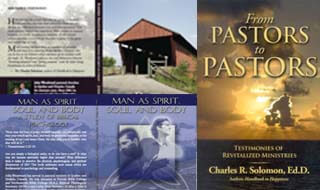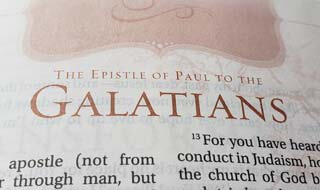Comments on
Frederic R. Howe’s journal article: A Review of Birthright, by David C. Needham
(Published in Bibliotheca Sacra, Jan-March, 1984)
It is understandable that an associate professor of Dallas Theological Seminary would object to some of Needham’s perspectives and terminology in Birthright. The book’s author speaks in terms of the believer’s new identity and unified spiritual nature as “a major corrective.” The traditional “two natures” position and terminology are criticized so that the theme of the believer’s new nature, new identity, and new potential could be presented in a more convincing manner.
The implication, however, is that seminaries, authors, and theology professors who have used these traditional concepts and terminology need this “corrective.” So, Dr. Howe takes issue with some of Needham’s points (so as to defend himself and others of the need to be corrected).
The reviewer agrees with the importance of regeneration and the believer’s identification with Christ. However, the way Needham presents these dynamic truths is challenged.
The nature of the believer’s co-crucifixion
Needham advocates this doctrine as meaning more than a positional/forensic identification. Other Exchanged life authors agree with Birthright. What we “know” about Romans 6:6 (that the old man was crucified with Him) has direct bearing on the implications of reckoning this true personally (as we are exhorted to do in Romans 6:10,11). Howe describes Needham’s position as that the believer “died in actuality” with Christ. Stating the position that way slants the argument in Howe’s favor; it is obvious that at some level the co-crucifixion was not literal. Therefore, the reviewer asserts that Needham rejects the forensic/judicial view of identification with Christ’s death.
I propose that both positions contain truth. It is not a question of either/or, but both/and. The believer was judicially co-crucified as Romans chapter 5 affirms:
“But the free gift is not like the offense. For if by the one man’s [Adam’s] offense many died, much more the grace of God and the gift by the grace of the one Man, Jesus Christ, abounded to many. And the gift is not like that which came through the one [Adam] who sinned. For the judgment which came from one offense [the Fall] resulted in condemnation, but the free gift which came from many offenses resulted in justification. For if by the one man’s offense death reigned through the one [Adam], much more those who receive abundance of grace and of the gift of righteousness will reign in life through the One, Jesus Christ. Therefore, as through one man’s [Adam’s] offense judgment came to all men, resulting in condemnation, even so through one Man’s [Christ’s] righteous act the free gift came to all men, resulting in justification of life” (Rom. 5:15-18).
Therefore, we can agree that the identification has to do with federal headship.
But Needham’s argument in Birthright is that the believer’s co-crucifixion and co-resurrection with Christ involves more than that. (Perhaps Needham could have avoided some resistance by describing it as “both” instead of only the spiritual aspect. But he chose to focus on the additional dimension that has been usually overlooked.)
The Role of Man’s Makeup
If a theologian only sees man as dichotomous (body and soul), then there can be no additional feature of identification. So the idea of “actuality” seems absurd. But if one recognizes the trichotomy of man as spirit, soul, and body (1 Thess 5:23,24; Heb. 4;12), another dimension comes into focus. In addition to forensic justification and identification, there is an actual change in the believer’s spirit. Needham refers to spirit as “the deepest self.” The Exchanged Life trichotomist is in full agreement with Needham’s case. The old man can be defined as who we were in Adam legally and spiritually. Through our spiritual union with Christ we became partakers of the divine nature at the spirit level (2 Pet. 1;4), and the old man was put off (past tense – Rom. 6:6; Col. 3:9).
This distinction is also significant in differentiating spirit and soul. Professor Howe asks, “If the believer’s death with Christ is ‘actual’, then exactly what is meant by Romans 6:11? If death means the cessation of existence actually, then why does Paul urge believers in that verse to reckon …themselves to be dead to sin?…this is not merely a semantic issue.”
Howe’s question is answered by discerning the distinction soul and spirit. The “actual’ aspect of co-crucifixion is the spirit’s change: the old man being put off at Calvary and the new man (regenerated and united with Christ) being put on. However, reckoning this true is vital to benefit from this miracle at the experientially. So, reckoning is agreeing with one’s mind and will (soul faculties) that God’s Word is true concerning identification with Christ. As Paul testified,
“I have been crucified with Christ; it is no longer I who live, but Christ lives in me; and the life which I now live in the flesh I live by faith in the Son of God, who loved me and gave Himself for me” (Gal. 2:20).
Clarifying the meaning of “Person”
Birthright is sounding a trumpet about some significant insights, but some of the the author’s terminology is rejected by the reviewer. Needham repeatedly affirms that the believer is a new person. Professor Howe also cites comments from Charles Smith that take exception to Needham’s description of the believer as a totally new person: “The pre-regeneration person no longer exists…! [in Needham’s wording]. One wonders, in this approach, who was saved? It wasn’t ME because the old me DOES not exist and the present ME did not exist.” I think these comments require us to agree that Birthright needs to sharpen its terminology and definitions, but this does not cancel the crucial biblical themes and insights that Needham effectively communicates.
Then how can Birthright’s emphasis on judicial and spiritual (“actual”) co-crucifixion and co-resurrection be more defensibly stated? I propose we speak in terms of “spiritual personhood.” Technically we are the same people after regeneration (as Howe and Smith argue), yet we are fundamentally new in terms of our spiritual identity (which is based on the new man as regenerated spirit. Paul exhorts us in light of this essential change: “and that you put on the new man which was created according to God, in true righteousness and holiness” (Eph. 4:24) So, the new man is the believer’s essential identity. This gives a solid basis to the New Testament’s forty plus references to the wonderful aspects of the Christian’s new identity in Christ; they as more than “positional” offices or titles.
Perhaps a contrasting analogy would be useful. Consider the sad case of a man who undergoes a sex change operation. Following surgery and taking female hormones, “she” adopts a different identity as a woman. This can be legalized with a new female name given. We can still assert that he/she is still the same person, however, this new identity is more than legal; it would also physical (“actual”).
Now we return from this negative analogy to the positive one. The regenerated believer (due to his identification with Christ in death, burial, resurrection and ascension) is a new person in the sense of his spiritual identity. He is still the same person in an individual sense, but his new identity is more than legal/positional. The spiritual identity change is real. This truth is emphasized in Birthright.
~~~~~~~~~~~
For more evidence to use “flesh” as distinct from the “old man” or “old nature, see the appendix of Birthright online at: https://gracenotebook.com/the-relationship-between-the-terms-old-man-and-flesh/
See also: Does the Believer Have Two natures? https://gracenotebook.com/does-the-believer-have-two-natures/
For further information on the trichotomy of man and its implications for sanctification see this reviewer’s book, Man as Spirit, Soul, and Body: A Study of Biblical Psychology – at http://www.biblicalpsychology.net

















